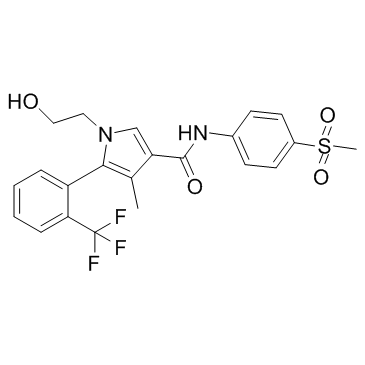1632006-28-0
| Name | esaxerenone |
|---|---|
| Synonyms |
1-(2-Hydroxyethyl)-4-methyl-N-[4-(methylsulfonyl)phenyl]-5-[2-(trifluoromethyl)phenyl]-1H-pyrrole-3-carboxamide
1H-Pyrrole-3-carboxamide, 1-(2-hydroxyethyl)-4-methyl-N-[4-(methylsulfonyl)phenyl]-5-[2-(trifluoromethyl)phenyl]- UNII:N62TGJ04A1 esaxerenone |
| Description | Esaxerenone is a novel, highly potent and selective non-steroidal mineralocorticoid receptor antagonist. |
|---|---|
| Related Catalog | |
| Target |
Mineralocorticoid receptor[1] |
| In Vivo | After single oral administration of Esaxerenone at 0.1, 0.3, 1, and 3 mg/kg, maximum plasma concentration (Cmax) and the area under the plasma concentration versus time curve (AUC) are increased with dose. Time to reach the maximum plasma concentration (Tmax) of Esaxerenone ranges from 2.0 to 4.5 h. After intravenous administration of Esaxerenone at 0.1, 0.3, 1, and 3 mg/kg, the total body clearance (CL) and distribution volume at steady state (Vss) are 3.53 to 6.69 mL/min/kg and 1.47 to 2.49 L/kg, respectively, in rats, and 2.79 to 3.69 mL/min/kg and 1.34 to 1.54 L/kg, respectively, in cynomolgus monkeys. Up to 168 h after administration, 3.9% and 91.4% of dosed radioactivity are excreted in rat urine and feces, respectively, and 95.2% in total. In monkeys, the excreted radioactivity up to 168 h is 11.5% in urine, 82.3% in feces, and 93.9% in total[1]. |
| Animal Admin | Esaxerenone dissolved in vehicle is administered orally or intravenously at doses of 0.1, 0.3, 1, and 3 mg/kg to rats (8 weeks old, 285 to 313 g, four animals per group) or to cynomolgus monkeys (3 to 5 years old, 3.37 to 4.48 kg, four animals per group). The blood is collected with heparinized needles and syringes at the designated sample collection times from the cervical veins of the rats and from the femoral veins of the monkeys. Plasma is obtained by centrifugation (4°C, 1710×g, 15 min) and stored at -80 °C before analysis. To rats (6 weeks old, 146 to 154 g, 4 animals), [14C] Esaxerenone is orally administered at a single dose of 1 mg/kg prepared in vehicle. Urine and feces are collected for the designated periods. For the monkey study, [14C] Esaxerenone suspended in 0.5% Methylcellulose (MC) is orally administered to cynomolgus monkeys (3 years old, 2.9 to 3.5 kg, three animals) at a single dose of 1 mg/kg. Urine and feces are collected for a designated period up to 168 h post-dose[1]. |
| References |
| Density | 1.4±0.1 g/cm3 |
|---|---|
| Boiling Point | 581.3±50.0 °C at 760 mmHg |
| Molecular Formula | C22H21F3N2O4S |
| Molecular Weight | 466.473 |
| Flash Point | 305.4±30.1 °C |
| Exact Mass | 466.117401 |
| LogP | 3.15 |
| Vapour Pressure | 0.0±1.7 mmHg at 25°C |
| Index of Refraction | 1.581 |
| Storage condition | 2-8℃ |
